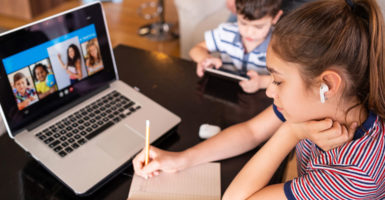When elementary and secondary schools began closing in March due to the coronavirus pandemic, most parents assumed they would reopen in a matter of weeks.
Instead, schools across the country have remained closed and will likely remain closed for the rest of the academic year.
When states closed schools, most encouraged school districts to move instruction online. But the degree to which they’re doing so varies greatly.
>>> When can America reopen? The National Coronavirus Recovery Commission, a project of The Heritage Foundation, is gathering America’s top thinkers together to figure that out. Learn more here.
A few converted to online platforms seamlessly after they shut down their physical presence. Many more took more than a month to do so, and some still haven’t, nearly two months later, been able to provide the education parents, as taxpayers, are paying for.
More than two months into this pandemic, an estimated one-third of school districts tracked by the Center on Reinventing Public Education, representing hundreds of thousands of students across the country, are not requiring schools to provide remote instruction.
Some, like Miami-Dade in Florida and Boulder Valley in Colorado, have done a solid job, transitioning to a fully online curriculum with teacher instruction and monitoring of student progress. But then there are the many other districts that are providing curriculum and instruction, but not formally monitoring student progress.
D.C. public schools, for example, provide online learning assignments and virtual office hours, but attendance is not taken and students are not penalized for missing work.
The Wichita, Kansas, school district is providing material that equates to about one hour of content per week to students in grades K-5, and about three hours per week for students in middle school.
The Newark, New Jersey, school district has provided “work-at-home packets” to students to complete and return once school resumes.
Then there is the category of districts that are, effectively, providing no formal instruction.
In Virginia, the Fairfax County school district enrolls more than 187,000 students but provides access only to general education resources.
Clark County, Nevada, the sixth-largest school district in the country, is not requiring teachers to provide any online instruction.
In a move that may make parents nostalgic for the 1980s, but longing for more academic rigor, some are using a combination of paper packets and public television broadcasts.
At this point, it almost feels as though taxpaying parents deserve a refund.
What would such a refund look like? Revenue per pupil in Clark County, Nevada, where teachers are not required to provide any online instruction, totaled $5,946 in district revenue and $3,081 in state funding, for a total (not including federal sources) of more than $9,000 per student per year in 2016.
In Wichita, revenue per pupil was $3,226 in 2016. Combined with state revenue, which totaled $8,400, revenue per pupil there exceeds $11,600 per year—and that’s before federal funding is added in.
In Fairfax County, which largely has failed to provide students any meaningful instruction or content online during the pandemic, local revenue ($10,791) added to state revenue ($3,242) means parents are financing more than $14,000 in revenue per pupil per year, not including federal funding.
Moreover, families are currently barred from entering the physical school buildings their tax dollars are supporting.
Where this has happened in higher education, college students have instigated class-action lawsuits, demanding partial refunds since they cannot access their campuses. They argue they are receiving less of the educational experience their colleges promised to deliver when they paid tuition upfront.
K-12 school districts also have made a promise to families; namely, that in exchange for significant property tax payments, sales tax charges, bond referenda, and income tax duties, they would provide an education to their children.
Too many districts are failing to uphold their end of that contractual obligation.
Families should immediately be provided with a refund—a prorated portion of the money that would have been spent by the state in which they reside and by their local school district from the beginning of March through the end of the school year.
Those dollars should be placed in a restricted-use education savings account that parents could use to pay for virtual tutors, online learning, textbooks, curriculums, diagnostic tests, and other products and services, in order to maintain education continuity for their children during this crisis.
An immediate, prorated refund would be a targeted response tied to the coronavirus right now to ensure that students don’t have to wait any longer to continue their learning.
Such a refund would build on the principle that education funding should always be student-centered and portable, rather than institutional.
In order to weather this storm (and the next), public education dollars should fund the student, and be used in whatever learning environment or school is the best fit for them.

























